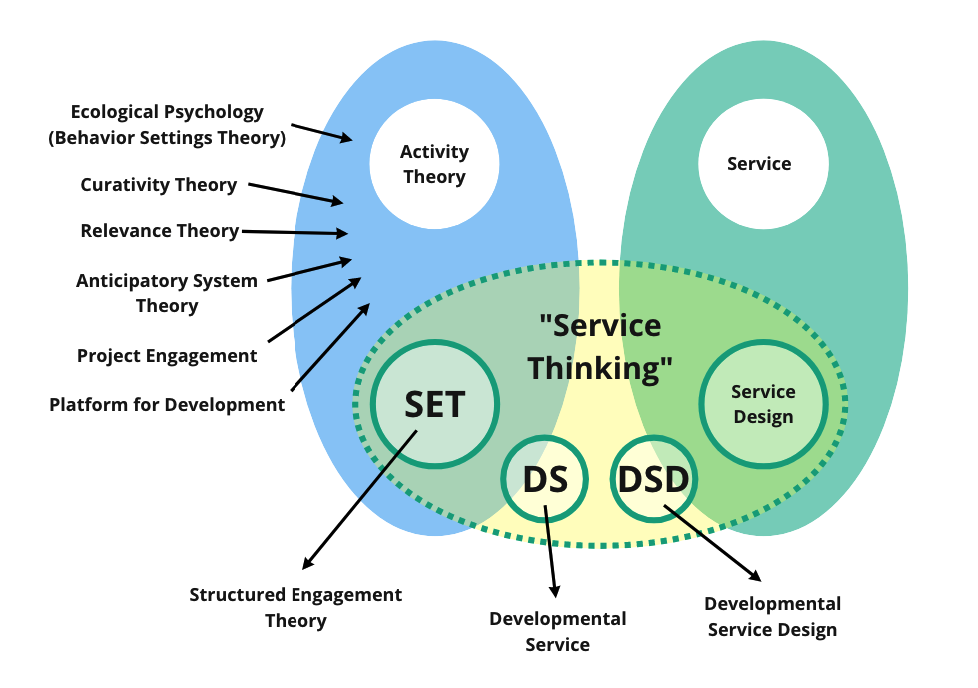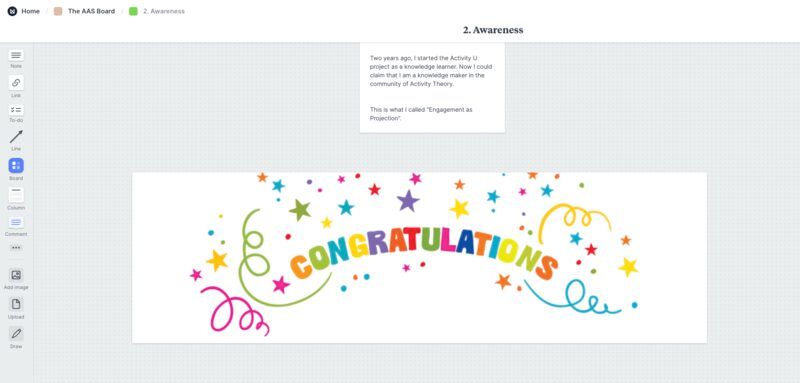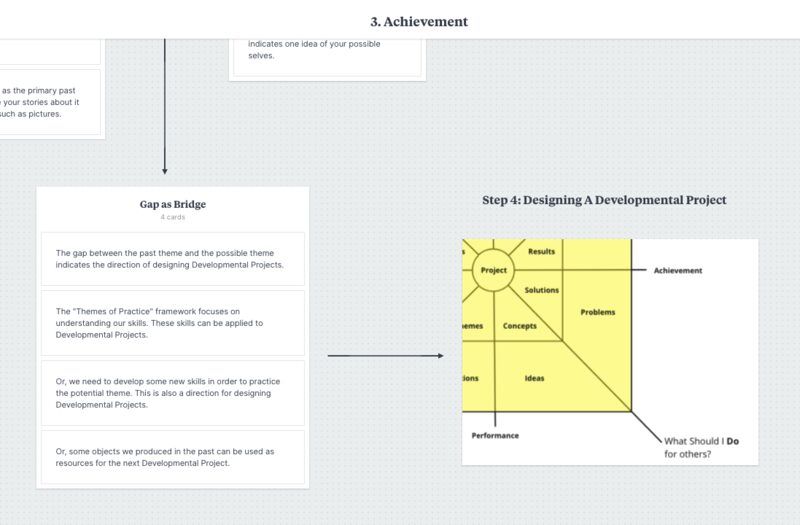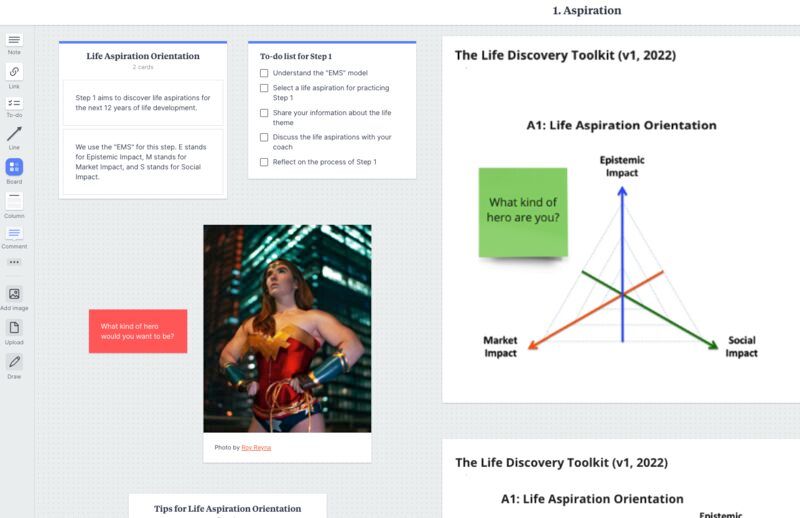Developmental Service Design (DSD)

Service Thinking and Doing
The notion of “Developmental Service” refers to a special type of service such as educational services, summer camps, adult life development programs, life discovery activities, etc. This notion refers to my own perspective of individual development.
In 2021, I used the SET framework to study Digital Whiteboard Platforms. I recently used the SET framework to study an adult developmental program. This change encourages me to think about the connection between Activity Theory and Service Design. See the diagram below.

Finally, I found the notion of “Developmental Service Design” to be a great connector.
- SET: Structured Engagement Theory
- DS: Developmental Service
- DSD: Developmental Service Design
- SD: Service Design
Since Developmental Service is a special type of service, Developmental Service Design is part of Service Design too.
According to Marc Stickdorn and Jakob Schneider, authors of This Is Service Design Thinking, “Service Design is an interdisciplinary approach that combines different methods and tools from various disciplines. It is a new way of thinking as opposed to a new stand-alone academic discipline. Service design is an evolving approach, this is particularly apparent in the fact that, as yet, there is no common definition or clearly articulated language of service design.”(2011, p.29)
In 2017, they published a new book titled This is Service Design Doing which is a practitioner’s handbook. They point out that “Service Design adopts the mindset and workflow of the Design Process, combining an active, iterative approach with a flexible and relatively light-weight set of tools borrowed from marketing, branding, user experience, and elsewhere. ”(2017, p.13)
The Service Design community shares tools (such as Journey Mapping, Prototyping tools, Business Model Canvas, etc) with other communities such as Lean Startup community, Design Thinking community, etc.
Developmental Service Design could adopt the mindset and workflow of the Design Process and tools from the Service Design community, it also could expand its toolkits from Developmental Service Study.
This is the fantastic engagement between Theory and Practice. Each dialogue always leads to a new creative space.
An Example of Developmental Service Design
In April 2022, I started hosting a 1:1 life coaching program on Milanote. The program is called AAS4LT which stands for Anticipatory Activity Systems (AAS) for Life Transitions (LT). See the screenshot below.

The AAS4LT framework was formed with 8 steps.
- Aspiration
- Awareness
- Achievement
- Design
- Deployment
- Delivery
- Modeling
- Storytelling
The AAS4LT framework aims to offer life coaches a new tool for dealing with life transitions from the perspective of the Anticipatory Activity System framework. Though theoretical support is very important, the result depends on the long-term engagement between life coaches and clients.
You can find more details about the AAS framework and the AAS4LT framework here.
I use Milanote to build a prototype of the AAS4LT 1:1 life coaching program.
The program is based on the following knowledge models:
- The AAS4LT framework
- The Life-as-Project approach
- The Life Discovery Toolkit (v1.0)
- The Life Discovery Canvas (v1.0)

The program is designed with the above eight steps. Each step has its own sub-board where I and a client can work together on the following tasks:
- 1. Understanding The Concept
- 2. Understanding The Example
- 3. Share Your Information
- 4. Discussions
- 5. Reflection
Task 1 and Task 2 are for the client to learn basic ideas about each step. For Task 3, the client has to reflect on her or his own situations and experiences and share relevant information through text, images, links, etc on the sub-board. I will lead Task 4 and respond to the client’s information. Task 5 is for both of us.
You can find more details in CALL for LIFE: Anticipatory Activity System for Life Transitions.
I wrote some notes about the program and my design process. Below are three notes I publicly shared.
Note on Life Awareness
This week we closed Step 2 (Awareness). This is a wonderful milestone. Each time, I use a picture of "congratulations" to close the step. See the screenshot below.

Note on Life Achievement
I am hosting a 1:1 life coaching program on Milanote. The program is designed with 9 boards, one is for the homepage of the program, and the others are about 8 steps.
Step 3 is called Life Achievement. I adopt the "Themes of Practice" framework for this step. Clients have to select a primary theme in the past years and share some stories about the real "practices" of the particular theme.
Some clients will write "Past themes" and "Possible themes" for this step.
The gap between "Past themes" and "Possible themes" is a great bridge for Designing Developmental Projects (which is the goal of Step 4).
Also, Step 3 refers to the "Concepts - Ideas" mapping of the Life Discovery Canvas. You can find more details about the canvas in The Life Discovery Canvas (v1.0) — Part 3B: Concepts (SAY and DO).

Note on the second round of the AAS4LT program
Today I start the second round of the #AAS4LT program. The picture below is a screenshot of the new version of the AAS4LT board.
The old version uses "The AAS Board" to name the space. The new version uses "Client's name + AAS Board" to name the space. The name means the board is a 1:1 private space.
I add a To-do List for Step 1. The old version doesn't have this.
I also add a picture for the question "What kind of hero would you want to be". If the next client is a boy, I'd like to use a new picture :)
I also add "Tips for Life Aspiration Orientation" to the Intro area.
Finally, I also add the message about openness to the Intro area.
"If you don't like the EMS model, you can use other tools or you can directly tell what you think about your future life."
I use the EMS model for Life Aspiration Orientation. The EMS model stands for "Epistemic Impact - Market Impact - Social Impact". It is just a heuristic tool for life coaching activities.
There are many heuristic tools for life coaching activity, you can pick what you want for our conversation.

You can find more on Linkedin with the hashtag #AAS4LT.
The Concept of “Service”
I also want to mention a theoretical concept called “Supportance” which is a core concept of the Ecological Practice Approach. In 2021, I applied the idea to develop the Platform for Development framework. I also used it to develop the Lifesystem framework.
From the perspective of the Ecological Practice Approach, the concept of “Supportance” is a perfect concept for understanding the concept of “Service”. I’d like to emphasize the Ecological Practice Approach is inspired by Ecological Psychology, it’s not a theory of economic theory.
While we tend to understand the concept of “Service” from the economic perspective, it doesn’t mean we can’t understand the concept of “Service” from other perspectives.
What’s “Supportance”? I published The Concept of Supportance: An Ecological Approach to Social Support and Beyond on March 12, 2021. The article started with the picture below.

Two women are standing on the beach by the sea, carrying a big picture frame. It is a normal sense. How can I use it for theoretical development?
Let’s consider it as a minimal collective activity. There are at least three people here, the two women carrying the frame, and a photographer taking the picture. It is worth noting that any one of these three people is an indispensable component of the activity. Without the photographer, no one came to take this picture. If there is only one woman, she can’t carry such a big picture frame, thus this shooting activity — taking such a specific photo — can’t be accomplished.
Usually, the story I described could lead readers to the notion of ‘Social Support.’ Traditionally, researchers pay attention to the effect of social support on health, quality of life, and especially mental health. I aim to adopt the ecological practice approach to discuss the notion of ‘social support’ in a broader scope in a general sense.
Suppose there is only one woman and a 3-year-old girl at the scene. The woman can’t hold the picture frame because the little girl doesn’t have enough strength to help her. Thus, the woman should look for potential support from others who could offer such support with corresponding capacities.
The concept of Supportance refers to potential supportive action possibilities offered by the social environments. It is inspired by Ecological psychologist James J. Gibson’s concept of Affordance which refers to potential action possibilities offered by environments. Both two concepts are potential action possibilities. However, the concept of Affordance can be applied to both animals and humans and Gibson uses it for talking about visual perception. In order to discuss potential supportive action possibilities between a person and other people and social environments in general, I coined the term Supportance and developed it as a theoretical concept for the Ecological Practice approach.
To be honest, I didn’t think about “Service” when I was working on the concept of “Supportance” in March 2021. Now we can use the concept of “Supportance” to understand the concept of “Service”. Let’s look at the definition of “Supportance”:
The concept of Supportance refers to potential supportive action possibilities offered from a social environment.
Moreover, from the perspective of Supportance, ‘support’ means not only intended support but also unintended support.
- Intended support: Person A intends to give some support to person B.
- Unintended support: Person A doesn’t intend to give some support to person B, but person B actualizes some supportances which are offered by Person A.
Both intended support and unintended support require Perception and Capability from Person B, however, unintended support doesn’t require Intentionality from Person A. The same logic can be applied to the level of institutionalized actions.
Since Supportance is potential, if we don’t talk about its actualization, then this concept doesn’t have any value. Once we pay attention to the actualization of supportances, we see a new creative space for developing a new theory of social actions.

The above diagram roughly presents my ideas on the Actualization of Supportances which considers a structure of three phases. Phase 1 is Perception, it focuses on the transformation between Potential and Actual. Phase 2 is Action, it focuses on the transformation between Challenge and Response. Phase 3 is Curation, which focuses on the transformation between Individual and Collective. As a dynamic process, these three phases don’t form a simple linear process. Phase 2 and phase 3 often provide feedback to phase 1.
If we apply the above Supportance Framework to discuss “Service”, then we can consider “Service” as the “Actualization of Intended Supportance”.
Why didn’t I connect “Service” with the concept of “Supportance”? Because my primary interest is “Unintended Supportance”. However, I recently started paying attention to “Intended Supportance” after having a discussion about charity with a friend.
So, this is my view on the concept of “Service” from the Ecological Practice approach.
If you want to explore more perspectives on the concept of “Service”, you can check out the following ideas:
You can also recommend relevant perspectives by leaving a comment.
